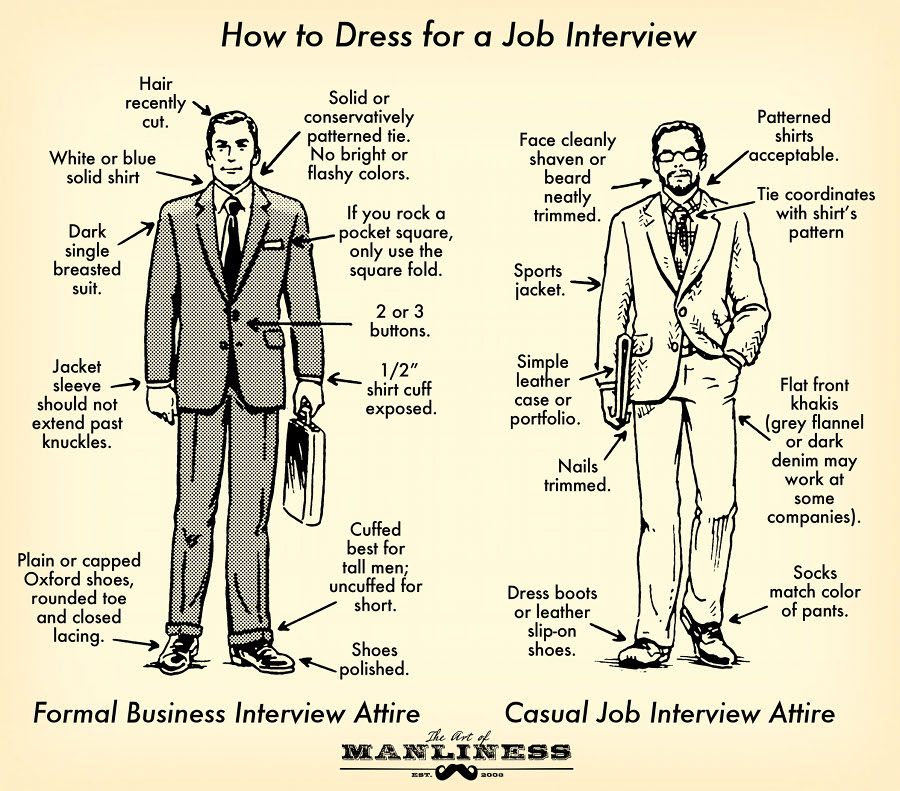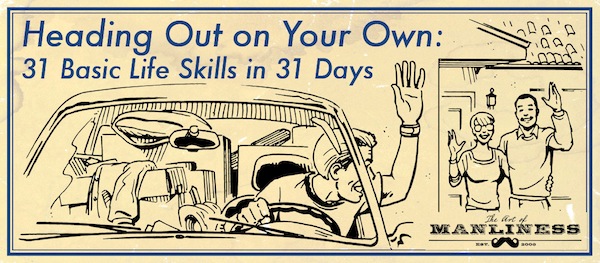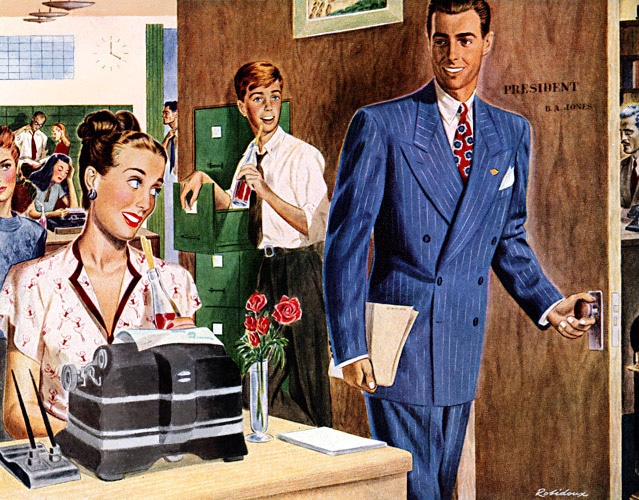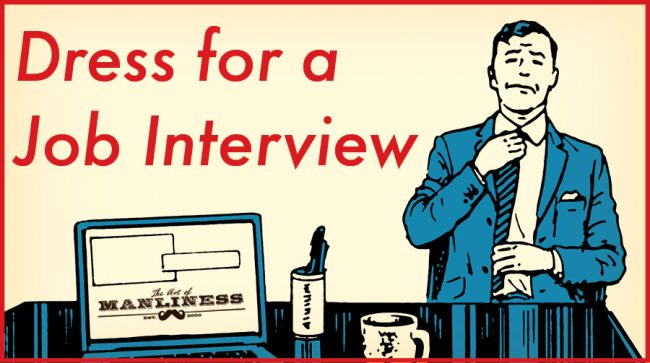
Yesterday, we laid out the reasons why what you wear to a job interview is very important. We also debunked a common myth: a formal business suit is not always the right outfit for an interview. It often is, and if you really have nothing else to go on it’s probably your safest default, but be aware that overdressing can cost you a job just as easily as underdressing. A guy who shows up to interview for an hourly wage job at a garage in a suit and tie doesn’t look like someone who understands the culture of that workplace or who’s going to stick around for long — he’s clearly got his mind on bigger and better positions.
Below we walk you through not only the overarching rule to keep in mind when deciding what to wear for a job interview, but also the five categories of dress codes to know, the specific clothes to wear for each code, and even grooming tips to take you up a notch.
The “One Step Higher” Rule
Your best rule for interview clothing is this: dress one significant level of formality higher than you would for a day on the job.
In shorthand, that’s the “One Step Higher” rule. It means that if on a normal day you’d be wearing khakis and a dress shirt but no tie, you should show up at the interview in slacks, a blazer, and a shirt with a tie, but not a suit. If you’d be wearing jeans and a polo at the job, wear khakis and a tie but no jacket. And so on.
All well and good, you say, but at an interview you haven’t yet worked a day at the company. You probably haven’t seen the employee handbook, HR manual, dress code, or wherever else they lay out clothing standards, either. So how do you know what the base level of formality is, and therefore how to dress one step higher than it?
A smart interviewee will take the time to figure out a company’s dress standards before going to the interview. Depending on your connections, you can do this in one of three ways:
Inside Information: Ask someone who works there. Obviously, not everyone has this option, though in some cases the offer of an interview comes with instructions along the lines of “no need to wear a suit” or “dress professionally.” It’s also possible in some cases to e-mail the supervisor you’d be working for and say “I’m thrilled I got the interview — what would you recommend I wear?” or words to that effect. Internal recommendations of any kind are the best cues you’re going to get, so if you’ve got a source, use it.
Make a Visit: If you don’t have a source on the inside, and you don’t want to ask, take a trip to the office and see for yourself. If you get there at the start or end of the workday you should be able to see plenty of people coming or going in their daily uniforms. In most cases you can get into the lobby as well, though you may need to introduce yourself to the receptionist.
Online Snooping: Some companies have an active presence on the web, and you’ll be able to do some sleuthing to determine what folks who work there are generally wearing. Either on a website, or some social media account, you may be able to find a behind-the-scenes or work party pic. Use those as a rough guide for the general office dress code.
Educated Guessing: In the case of a distant company where you don’t know anyone, you don’t have a lot of good options. The best you can do is determine the general standards of your industry and err on the side of the highest standards. In each of the following sections we talk about how to dress to each standard, but we’ll also start with a list of industries where that particular standard is common. It’s not 100% foolproof, but you can usually make assumptions along the lines of “wear a suit to interview for a job at a bank,” or “don’t wear a tie to interview for a hands-on job at a ranch.”
However you figure out what an employee in the position you’re applying for would normally wear to work, remember the One Step Higher rule: dress one significant level of formality higher than you would for a day on the job.
Levels of Formality: The Five Categories for Interviews
To break it down in a little more detail, here are the broad categories of formality that you should be using as your categories or “steps” of formality:
- Strict Business Dress
- Business Dress
- Business Casual
- Casual
- Work Clothes
Let’s look at each in more detail.
The Strict Business Dress Interview
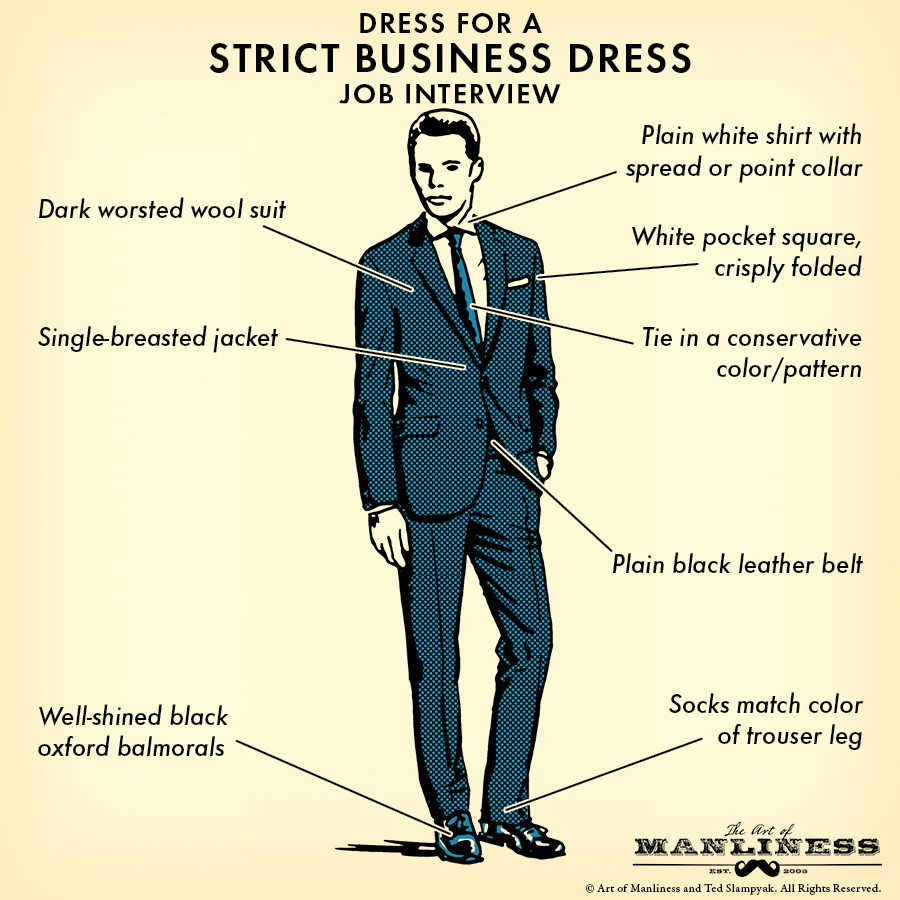
Business dress is a category with some flexibility to it, which is why we’ve set “strict business dress” aside as its own category apart from just “business dress.” This is where you not only need to be dressing like a businessman, but like a businessman making the most formal and conservative choices.
When You Should Interview in Strict Business Dress
If you’re interviewing for a job that requires you to wear a business suit every day, the only way to dress more formally for the interview is to wear a business suit really well, with perfectly executed details. Typically you dress this sharply when you’re applying in industries that already have high standards of presentation:
- Prominent law firms
- Most banking and financial positions
- Executive roles
- High-level political positions
The common thread here is jobs for powerful people. If everyone you’ll be working with wears suits already, your suit needs to impress.
Elements of Strict Business Dress
There’s no room for error and very little for personal expression when you’re trying to impress a well-dressed employer. Stick to the conservative interpretation of business clothing:
- The Suit: Worsted wool in either dark navy blue or dark charcoal gray with no patterning. Single-breasted jacket. Tailored fit, if possible; if you can’t afford custom clothing at least have your ready-to-wear suit adjusted for your measurements by a tailor.
- The Shirt: Plain white with a spread or point (not button-down) collar. Sharp collar points (use stays or starch or both), smooth front, no wrinkles; tailored fit if possible.
- The Shoes: Plain black oxford balmorals, well-shined. No alternatives. Socks should match the color of the trouser leg, i.e. charcoal gray socks with a charcoal gray suit.
- The Necktie: Conservative color and pattern – nothing bright or eye-catching. Long enough that the tip touches the belt/trouser waist, with no shirt showing in between, even when moving. Centered, symmetrical knot with a small dimple in the tie just below it.
- The Accents: Plain black leather belt with a small metal buckle (or dark-colored suspenders if no belt loops are present). White pocket square, crisply folded (point or horizontal style) in the jacket breast pocket. Simple metal or black leather band watch; any metal should match the belt buckle.
Because there’s very little room for personal expression at this level of formality, the details matter more than they will in situations where each applicant is more varied. Everything needs to be crisply pressed, sharp-edged, and very neat, and the fit of your clothing should be as close as possible.
Interviews requiring a strict business outfit are rare and usually high-stakes. You’re playing in the big leagues at this point. Don’t spare time or expense in getting yourself ready. For the kind of salaries involved in any job like that, it’s false economy to stint on your preparation.
The Business Dress Interview
“Strict” business dress is for impressing employers who routinely wear full business dress themselves. In most other interviews, even very formal ones, you can wear a business dress outfit (meaning a suit, collared shirt, and tie) with a little more freedom than you would in those strictest situations.
There are still rules and limitations, but there is room for some tastefully-done personal style.
When You Should Interview in Business Dress
You wear a business suit to interview for jobs where you might not be wearing a suit every day, but you might be called upon to for important meetings or presentations. It’s also a good standard to dress to when you’re applying for a job that doesn’t require suits but does typically expect you to wear a blazer or sports jacket and a tie, or slacks and a dress shirt.
Typical settings where you’d want a business dress outfit for your interview might include:
- Some casually-inclined law firms and banks
- Most managerial or administrative positions
- Business consulting jobs
- Public relations, advertising, and similar high-skill white collar jobs
- Many political or highly-placed public service positions
- Most teaching/academic positions
It may also be a good idea for people applying to low-skill jobs in high-status settings – even a secretarial position might be worth interviewing for in a business suit, if the position would be at a major financial institute or executive office suite. You want to look like you can fit in even if you’re not going to be the high-powered player yourself.
Elements of Business Dress
The fundamental expectations of business dress are that you’re wearing a business (not casual) suit, a white or white-based dress shirt, and a necktie, along with conservative accents. More specifically, it’s a combination of the following mandatory elements:
- The Suit: Dark colored, smooth textured; either no pattern or very fine white pinstripes. Stick to single-breasted jackets to avoid looking too flashy. Worsted wool is best, but any smooth, matte material will work. Tailored fit if possible.
- The Shirt: Plain white or white with light patterning. Point or spread (not button-down) collar. Pressed collar and shirtfront – no wrinkles; sharp collar points (collar stays will help). Tailored fit if possible.
- The Shoes: Black leather balmoral oxfords, polished. Socks should match trouser color – navy blue socks with a navy blue suit, etc.
- The Necktie: Any business-appropriate pattern that isn’t too flashy. Avoid shiny, reflective materials, bright colors, and overly-busy patterns. Centered and symmetrical knot with a small dimple just beneath it. Tie should be long enough to touch the belt/trouser waist with no bare shirt visible in between.
- The Accents: Black leather belt with a small metal buckle (or dark-colored suspenders, if the trousers have no belt loops). White or lightly-colored pocket square in the suit jacket’s breast pocket. Metal or black leather band watch; metal should match the belt buckle if one is present.
If you compare the two, you see that basic business dress differs from strict business dress primarily in that it allows a touch more color in the shirt, necktie, and pocket square. But beware of overdoing it – a hint of pastel in the shirt and pocket square is really more than enough to establish your individuality without looking too casual.
It’s worth noting that you’re unlikely to seem overdressed if you show up to a business dress interview in the strict business dress interpretation. You might not stand out quite as much as you will if you wear a really well-chosen dress shirt/pocket square combination, but you’re not going to get penalized for defaulting to plain white.
The Business Casual Interview
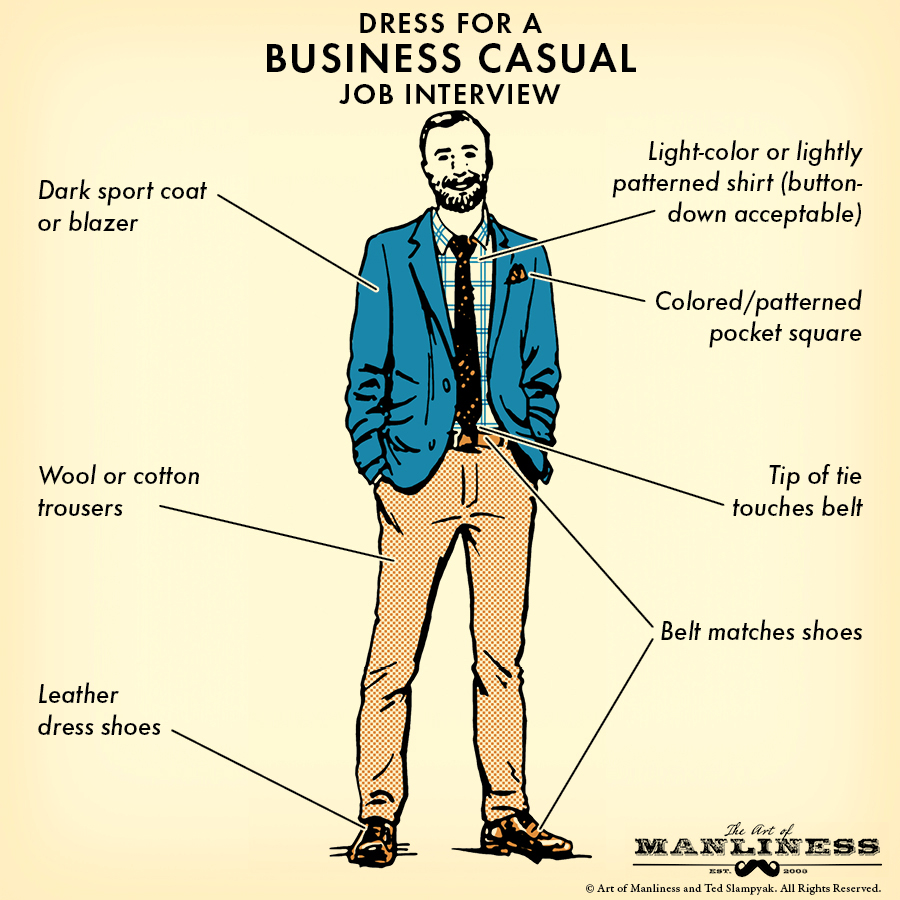
Young men should especially take the time to familiarize themselves with business casual options. Unless you’re in a particularly high-formality field like law or finance, most entry-level positions won’t require anything more than a shirt and maybe a necktie day-to-day, meaning that you don’t necessarily need an interview suit either.
When You Should Interview in Business Casual
Business casual is for any interview where a full suit looks too aggressive, high-status, or ambitious. Think of showing up in a blazer and good slacks rather than a matched suit. Plan on wearing business casual to interview for any job that requires professional dress but rarely expects suits and ties:
- Many entry- or mid-level small business cubicle/office jobs
- Clerical and civil service desk jobs
- Upscale retail positions
- Most political office and campaign roles
- Engineering, laboratory, software, and other tech-sector jobs
- Food service, particularly front-end (wait staff, bartender, etc.)
It’s a safe default standard for basically any job interview where a suit would be overkill.
Elements of Business Casual
Business casual can cover a wider range of options than the business dress categories. Always err on the conservative side, which means wearing both a jacket and a necktie – you’re not going to lose points for having either of those things, and in a picky interview you might lose points for leaving them at home.
Including the jacket and necktie, the fundamentals you need for a good business casual interview outfit are:
- The Jacket: A dark, non- or lightly-patterned sports coat or blazer, preferably wool. Some texture is all right (herringbone weave, etc.), but avoid aggressively casual elements like elbow patches. A navy blue blazer is always a safe default.
- The Trousers: Solid color with minimal texturing. Wool slacks are best, but cotton is acceptable. Crisply-pressed creases are a must. Gray, brown, or navy blue work in most situations, but avoid khakis, which are slightly less formal.
- The Shirt: Collared, but button-down collars are acceptable at this point. Some color is also appropriate, but keep it light – white, light patterns on white, or pastels; no deep hues or vividly bright colors. Make sure the front is pressed and the collar points are sharp.
- The Shoes: Black or dark brown leather dress shoes. No metal buckles, elaborate brogueing, or exotic textures (ostrich skin, etc.), but minor decorative elements are fine. Socks should match the trouser color; i.e., light gray socks with light gray slacks.
- The Necktie: Any color or pattern that isn’t too ostentatious is fair game, just be sure that it goes with the shirt, jacket, and slacks. Avoid anything very bright, very busily-patterned, or anything with a single printed graphic rather than a pattern (no Mickey Mouse ties). Tie should touch the top of the belt with no shirt visible in between.
- The Accents: A leather belt in the same color as the shoes. Wristwatch with either a metal or a leather band; metals should match the belt buckle and leathers should match the belt/shoes. Colored and/or patterned pocket square in the jacket breast pocket, in any neat fold (puff, point, horizontal, etc.).
Day-to-day wear in a dress casual environment will let you do things like replacing the jacket with a vest or a sweater, but for interview purposes stick to the basic formula of a conservative blazer with plain-colored dress slacks.
The Casual Interview

“Casual” is often misunderstood to mean “street clothes.” They’re not the same thing – a casual outfit is one that’s dispensed with business accents, not one where anything goes. The jacket and necktie aren’t a part of the equation anymore, but the outfit still has to look professional and well put-together.
When You Should Interview in Casual Clothing
It’s rare to go to an interview without even a jacket. When you do, it’s usually for a job where there is no dress code, or only a very loose one, and typically a job where the interview process itself is fairly relaxed as well. Mostly you’ll be able to wear casual clothes at interviews for service-sector jobs where hiring is done by a short application rather than a full résumé:
- Typical retail stores, especially chains
- Casual dining, foodservice, etc.
- Manual labor (assuming it’s not a hands-on skills interview)
- “Under the table” part-time jobs (dog walking, nannying/babysitting, etc.)
- Customer service
- Very casual start-up environments
You shouldn’t dress casually for an interview unless you’re very sure that the job is a jeans-and-T-shirt or company-issued polo shirt setting. At the point where you’d be expected to wear khakis and a collared shirt every day, you should go ahead and interview in business casual rather than casual.
Elements of Casual Clothing
For daily purposes “casual” is a huge category; for interviews it’s more limited. You want something that eliminates formal business elements like the blazer or suit jacket but that still looks respectable:
- The Shirt: Collared – either a dress shirt or a neat polo. It can be colored, but patterns should be reasonably restrained, nothing more than a two-colored striping. The shirt should be tucked in for the interview.
- The Trousers: Slacks, not blue jeans – khakis work well here. They don’t have to be nice wool slacks (though they can be), but they do need to be clean, well-pressed, and well-fitting.
- The Shoes: Leather rather than cloth or canvas. Casual styles like bluchers, brogues, saddle shoes, etc. are all fine, so long as they’re in good shape and recently polished. Dressier boots, loafers, or chukkas can work too. The socks should match the trousers (light tan socks with khakis, etc.), but in a pinch you can get away with socks that match the shoe leather instead.
- The Necktie: Optional, but worth considering. A jacket is definitely too fancy, but a necktie and a collared shirt with no jacket says that you’re an ordinary guy who’s making a nice gesture to acknowledge the importance of the setting. It certainly won’t hurt you, and it might be a handy leg up on the competition.
- The Accents: A leather belt that matches the shoes and a watch with either a metal or a leather band. Leathers and metals should match throughout the outfit.
The attitude you’re trying to project is someone who isn’t formal, but who knows that interviews are important settings where you should look your best. Keep everything neat, tucked-in, and well-fitting. You’ll look a little overdressed for the job, especially for any kind of manual labor position, but that’s the point.
The Hands-On or Skills Interview
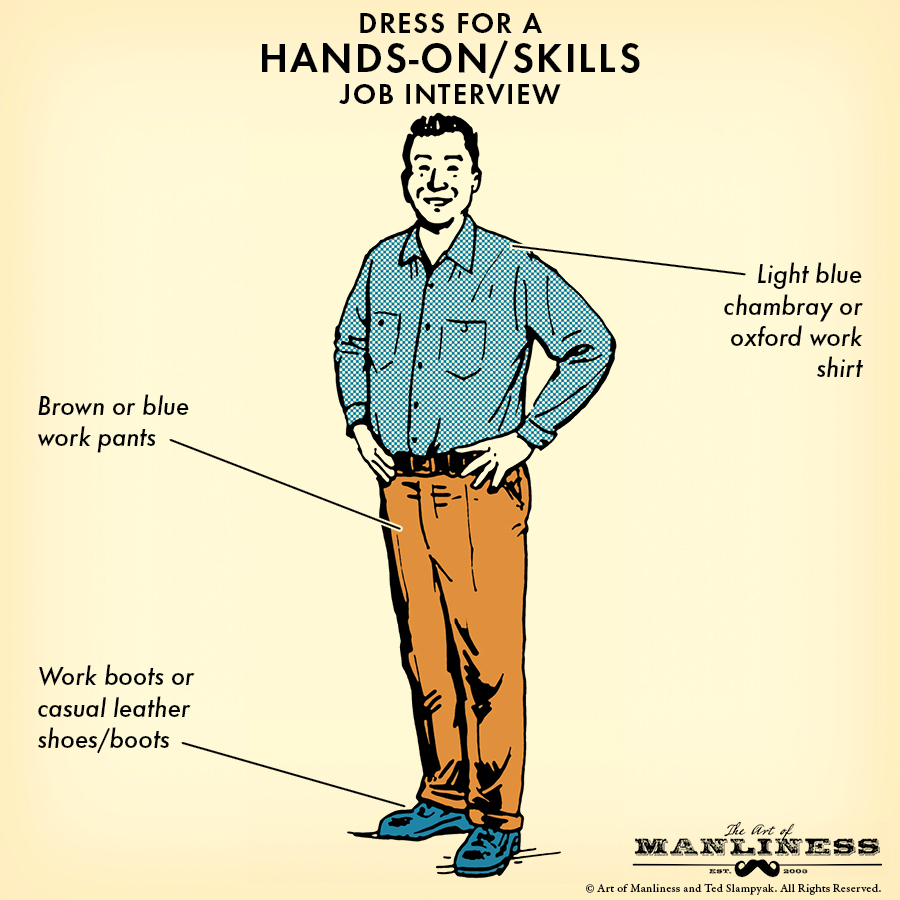
It’s increasingly common to actively test skills during the interview process, especially in skilled labor positions like carpentry or construction. The “let’s see what you can do” interview is a little different from the model in which you sit down and talk about your résumé and your career goals (though there may be some of that too, depending on the firm).
Dressing for these is about impressing the interviewer with your preparedness as much as it is about style. When you have to make the choice between formality and function, err on the side of function.
When to Dress for Hands-On Work
You’ll typically get warning if an interview is going to involve practical testing as well as question and answer. In some cases you won’t have to change what you’ll wear – if it’s a computer programming job, for example, a blazer or suit jacket isn’t going to hamper the practical part. But in many industries you can expect some hands-on skills testing that you’ll need to dress for specifically:
- Construction
- Skilled labor (plumbing, carpentry, etc.)
- Some landscaping/gardening positions
- Farm or ranch work
- Factory floor jobs (machinist, etc.)
Just keep in mind that not every employer within those industries is going to do hands-on testing and an interview in the same appointment. You usually want to dress by normal job interview standards unless you’ve been specifically told “we’ll be taking a look out on the factory floor” or “we’ll give you a chance to use the equipment” or something similar.
Elements of Dress for a Hands-On Interview
The priorities are a little different when you know you’re going to have to work with your hands. Mobility and safety are more important than style – but you still want to look good.
Your key pieces of clothing here are sturdy, practical items that can be dressed up by the addition of a jacket:
- The Jacket: You can take it off when needed, but throw a blazer or sports jacket on for that all-important first impression. The only time to leave it at home is if you’re only going for a skills test, with no sit-down interview involved at all. At that point it’s a needless frill and you won’t be impressing anyone by bringing it along. But if there’s a part that takes place in chairs in an office somewhere, have a jacket.
- The Trousers: Avoid light blue denim jeans. Wear khaki, navy, or brown work pants, instead – even if they’re just Dickies or Carhartts the color will make them seem more “professional.” If you’re told specifically to wear jeans, wear dark indigo instead of light blue.
- The Shirt: Something with a collar is better than something without, unless there’s a safety reason to avoid them (which is rare – button-down collars are usually considered machine-safe). A light blue chambray or oxford work shirt is timeless and classic.
- The Shoes: Workboots if it’s relevant, casual leather shoes or boots if it’s not. In either case make sure they’re clean and free of any major scuffs or tears.
- The Accents: Minimal, especially around machinery. A sturdy watch (nothing clunky and plastic, though) is fine as long as it’s not a safety hazard, and you’ll want a plain leather belt (again, unless it’s a safety hazard). Other than that, leave the pocket squares and neckties at home.
It’s a balancing act between practical and sharp-looking. When there’s a doubt, again, err on the side of practical – you’re applying for a hands-on job, and the employer is going to be impressed by a readiness to do the work more than by sharp-looking but unsuitable clothes.
Finishing Touches: Grooming for Any Kind of Interview
There are a few things you must do for any interview, of any type.
These are all minor but important presentational touches. They come down to basic grooming, and the whole catalogue can easily be accomplished in an hour or two at the outside.
As minor as they sound, these details do matter. They’re the difference between looking adequate and looking sharp. Most people don’t notice them on a conscious level, it’s just the combined effect of all the little touches that creates a general impression of neatness.
Give yourself the free advantage by taking care of the grooming details:
- Hair: Get it trimmed within a week of the interview. It doesn’t have to be a full cut, if you’ve already got the length you want, but have the bangs, sides, and back of the neck evened up. Wash the hair, put a little product in it if you use any, and give it plenty of time to dry before the interview so you’re not showing up still looking shiny-haired.
- Nails: Trim them and use a soft brush or a washcloth to buff the tips, cleaning any stray dirt out from under them. If you have to, dig out any entrenched dirt with a blunt toothpick, the rounded edge of a paper clip, or any other small, non-sharp desk item. Resist the temptation to use your pocketknife, no matter how cool it makes you feel.
- Skin: Shower ahead of time, give the face a scrub and put on deodorant but not cologne. Artificial scents are a social accent, not a business one, and shouldn’t be noticeable at an interview. If you use a powerfully-scented deodorant, go easy on it and give your pits a minute or two to air out before putting your interview shirt on.
- Underwear: It doesn’t have any bearing on formality, so you can wear the same stuff for any level of interview, but have a comfortable pair of undershorts on so you’re not squirming in your chair, and wear a low-necked undershirt to deal with sweat. You’ll be putting out more than you’re used to unless you’re very jaded indeed – interviews are high-pressure situations.
No single grooming step on its own is likely to make the difference between a successful interview and a failed one. But taking the time to do each one right certainly makes you look crisper, cleaner, and sharper around the edges – and it’ll help you feel more put-together and in charge of yourself, too, which is of no small benefit.
Conclusion: 3 Steps to Successful Interview Dressing
To summarize, there are three key steps to perfect interview dressing:
- Know Before You Go. Learn what the company’s dress and culture are like. Have a good sense for what you’d be wearing day to day on the job.
- Follow the “One Step Higher” Rule. Dress for the job you want, plus one level of formality.
- Take Care of Your Grooming Details. Plan the right outfit for the desired level of formality. Have it cleaned and pressed. Get your hair trimmed, your nails cleaned, and all the other little details you need to take yourself from “presentable” to “perfect.”
At that point you’re done, and you’re ready to reap the benefits of proper interview presentation: better first impressions, favorable assumptions from the interviewer, confidence in yourself, and a good showing of basic personal competence.
Good luck!
_____________________________
Written By Antonio Centeno
Founder, Real Men Real Style
Click here to grab my free ebooks on men’s style



